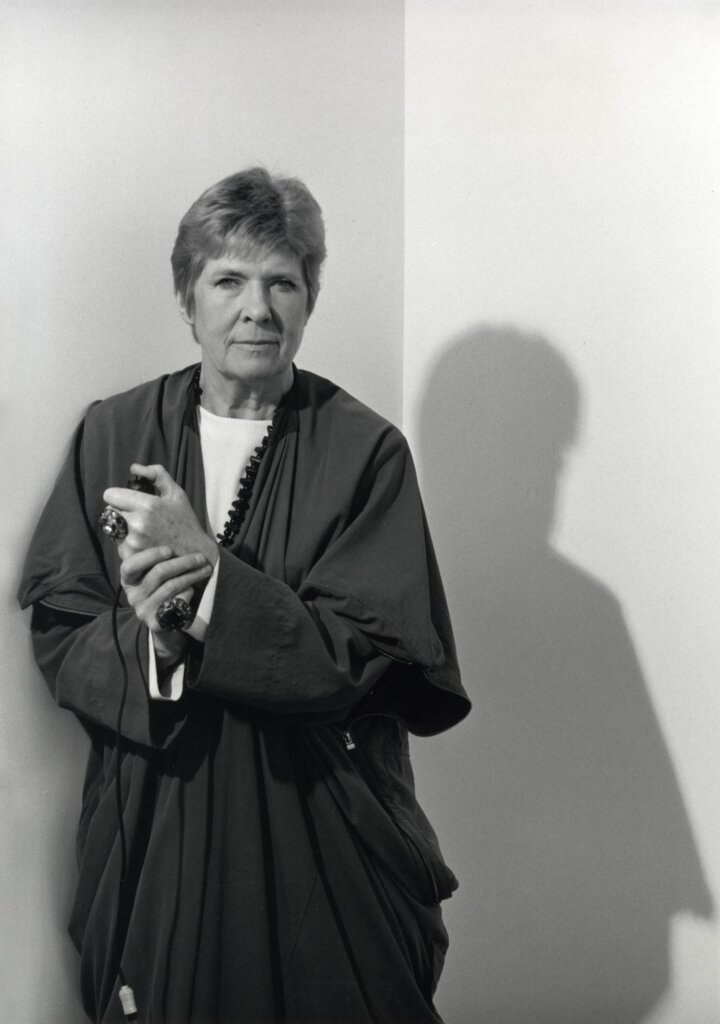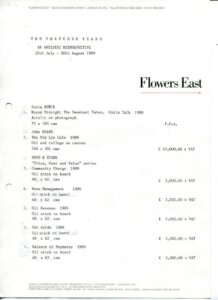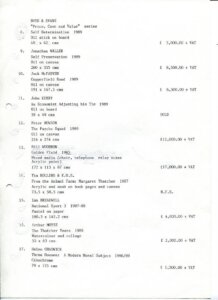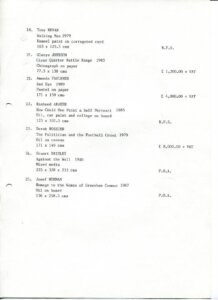Remembering Angela Flowers
It is with great sadness that we share the passing of pioneering British gallerist and businesswoman Angela Flowers, on 11th August 2023, at the age of 90. She championed the work of younger British artists for more than five decades and showed that, “women could be businesswomen and make an impact on things they were passionate about.”
She is survived by her five children, thirteen grandchildren, and three great-grandchildren. We at Heatherleys offer our condolences to her family, including her daughter in law, Heatherleys’ President, Nicola Hicks MBE.
A pioneering British gallerist and businesswoman… who championed the work of younger British artists for more than five decades.
Angela Mary Flowers (née Holland) opened her first gallery in London in 1970 and, over the five decades that followed, “pioneered an original and distinctive path through the British art scene”. She was a champion of contemporary art and become well known for her support of younger British artists, who she considered underrepresented by commercial galleries in the 1970s.

Born in Croydon, England, in 1932, Angela studied music at the Guildhall School of Music and Drama, and initially planned to have a career as a singer. Her passion for art was ignited in the 1950s, when her parents took her to visit artists’ studios in St. Ives. This introduced her to the work of living artists and inspired her to begin collecting.
She remained an ardent supporter of living artists throughout her lifetime, amassing an extensive personal collection that filled the walls of every home she lived in. Throughout her life Angela was a member of numerous exhibition juries and committees, and became a fellow of the Royal College of Art. She was also on the executive committee of the Society of London Art Dealers and the John Kobal foundation.
The largest commercial gallery space in London
Angela Flowers’ first London gallery space was on Lisle Street, above the Artists International Association (AIA). The AIA was a left-wing artist cooperative established in the 1930s. By the time the Angela Flowers Gallery came to occupy their attic room in 1970 they were primarily an exhibiting society, offering space in exchange for commission. The association disbanded in 1971 and the gallery moved to Portland Mews then, in 1978, to Tottenham Mews.
As the gallery expanded it added an east end space, Flowers East in Hackney, in 1988. At the time, this was the largest commercial gallery space in London. The following year, Matthew Flowers, Angela’s third son, took over day-to-day running of the business as Managing Director. Further expansion in 1991, added two vast exhibition spaces, housed a programme of acclaimed thematic shows, in which Angela placed work by well-known and celebrated artists alongside emerging names. These shows included The Thatcher Years – an Artistic Retrospective (1989) and Contemporary Portraits (1988).
Women could be businesswomen and make an impact on things they were passionate about.
In 1998 Flowers expanded her gallery internationally by opening a space in Los Angeles and, in the early 2000s, in New York and Hong Kong. The Hong Kong opening coincided with the 50 year anniversary of the gallery. The half-century milestone was marked by two London exhibitions, 50 x 50 and Fifty Years, which celebrated the gallery’s history covering more than 900 exhibitions, and the representation of more than 50 international artists and artist’s estates.
No such thing as a Flowers style
There was no such thing as a Flowers style, however, the gallery tended towards the established. They dealt solely with living artists and work made after 1952, however most of Flowers’ artistic family were born somewhat earlier.
Loyalty was a leading value for Flowers and many of the first exhibiting artists stayed through the gallery’s various iterations. Uncommonly for most London gallerists, some of Flowers’ artists stuck by her for over 30 years; including Tom Phillips, Derek Hirst and Bernard Cohen, as well as sculptor Nicola Hicks who married Flowers’ youngest son, Daniel. Other artists who showed in the gallery in those founding years included Jeff Nuttall, Ian Breakwell, feminist Penelope Slinger and Tom Phillips who had his first solo show there. Testament to Flowers’ values, several of those first artists are still represented today such as Boyd & Evans, David Hepher, and John Loker.
Critical attention
One of the early exhibitions was the Postcard Show for which Flowers commissioned original works to be made into postcards. These included works by Joseph Beuys, David Hockney, Richard Hamilton and Peter Blake. In 1983 Flowers founded the Artist of the Day programme which caught critical attention at the time and still runs today. The initiative champions young unsung artists through a series of 24 hour exhibitions. Angela didn’t select the artists herself, instead they were chosen by established artists who would nominate a fellow artist that they thought would benefit from an exhibition at the gallery. Choices ranged from emerging artists who had not yet shown to older artists they felt had been neglected. The first artist to be exhibited as part of Artist of the Day was Anthony Daley, selected by David Hepher.
From her beloved home in Rosscarbery in West Cork, Ireland, Angela staged seasonal exhibitions. Of these, the summer show ran for 15 years. The inaugural exhibition at Rosscarbery was of Irish-Scot still-life and landscape artist William Crozier.
Personal Life
Angela married her first husband, the late portrait and advertising photographer Adrian Flowers in 1952. A fellow art collector, he helped manage the gallery and took photos of the work. Together they had four children Adam, Matthew, Daniel and Francesca. Subsequently, Angela married the late journalist Robert Heller in 2003. They had one daughter, Rachel Heller, who was born with Down’s syndrome in 1973. To Angela’s delight Rachel became a talented and successful artist in her own right. Though Rachel was never represented by Flowers, in 2003 Angela gifted Rachel a solo exhibition at Flowers Gallery.
“I don’t mind a bit of nepotism,” Angela admitted “but I’d like to see her with another gallery.”
After Robert developed Parkinson’s disease at the turn of the century, the couple eventually decided to move from their home in Highgate, north London. They moved to a more manageable house near Henley-on-Thames, Oxfordshire, in 2009. There, they continued to host their notorious Easter and New Year’s parties and, typically, Angela converted the garden shed into an art gallery.
Angela Mary Flowers, gallery owner and businesswoman, born 19 December 1932; died 11 August 2023.


